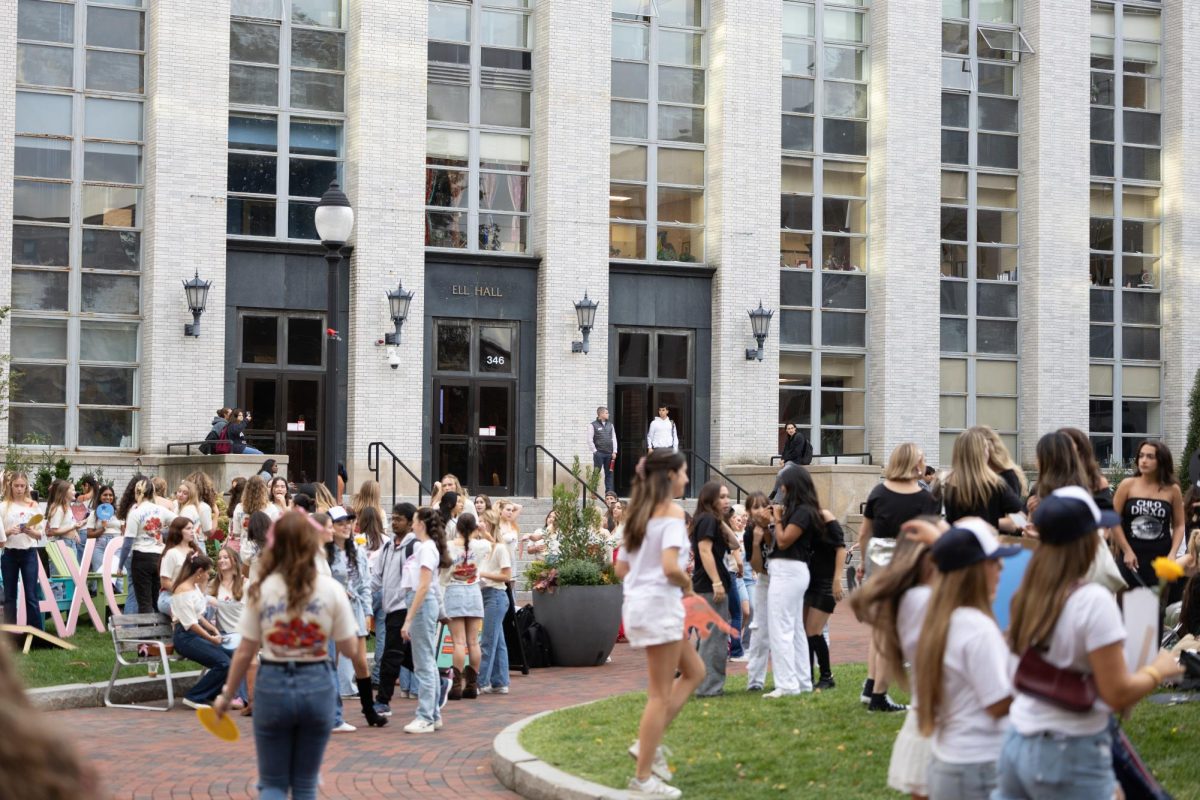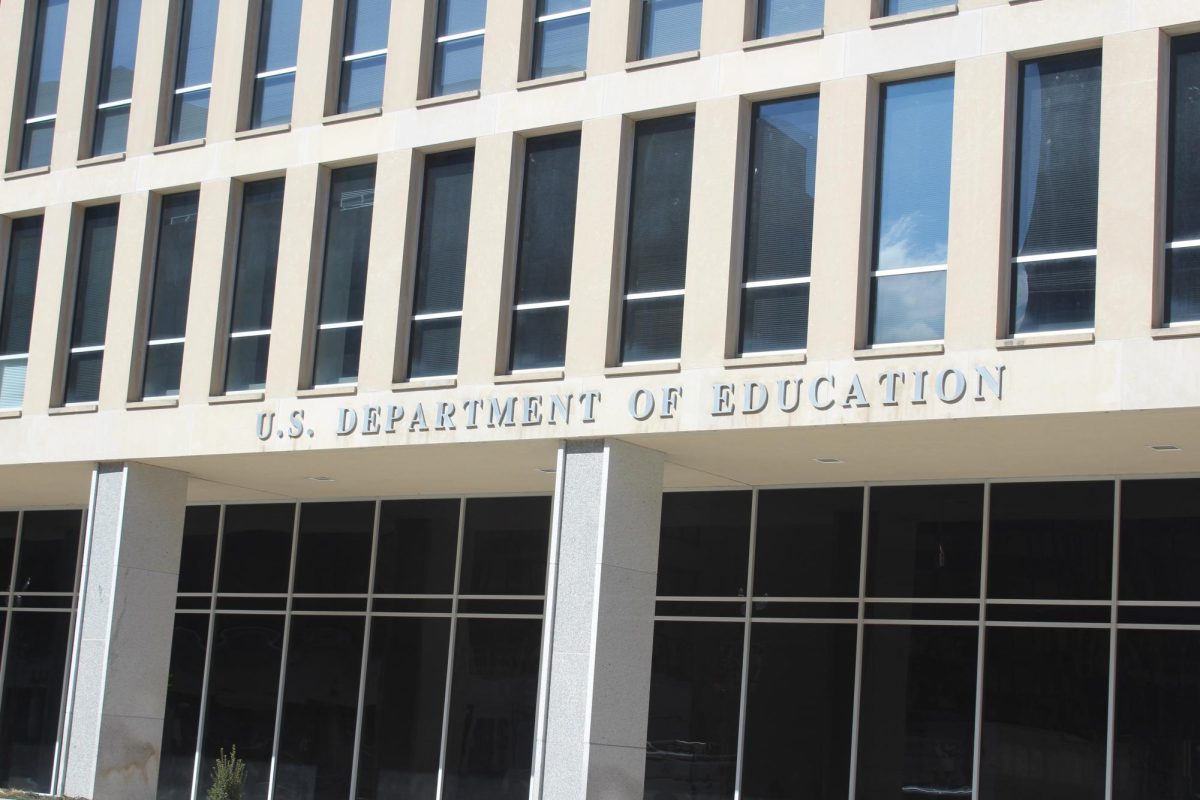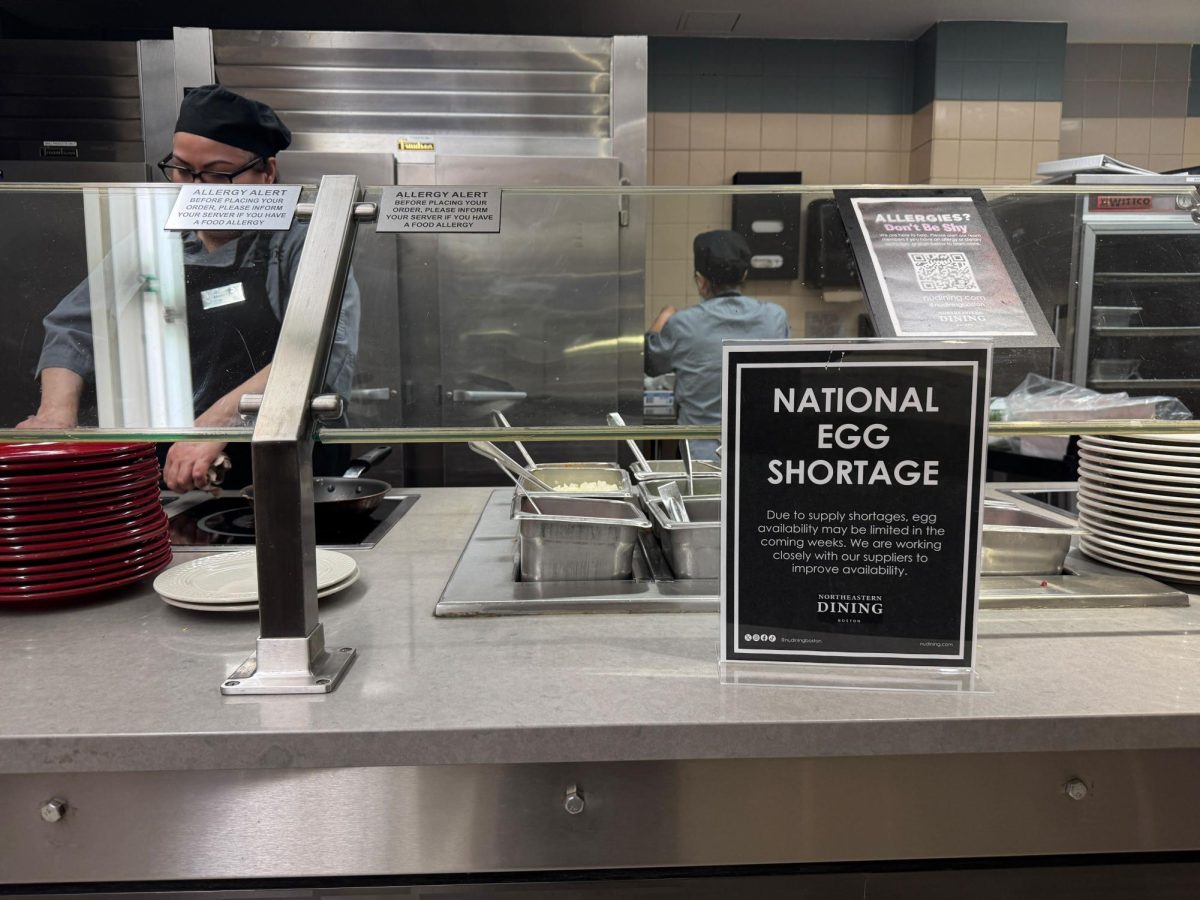Prior to her surgery, sophomore Sarah Belfit aspired to be a neurologist. Now, the psychology and former behavioral neuroscience major can speak to her future patients from experience. On Sept. 29, the 19-year-old underwent an operation at Children’s Hospital to remove a three-centimeter tumor in the left lateral ventricle at the center of her brain.
“If I was at all sort of halfway about what I wanted to do with my life, this was a sheer sign that this is the field I want to go into,” Belfit said.
During her freshman year, she was plagued by frequent headaches that caused vision distortion and “tingly” sensations in parts of her body. This past September, Belfit was diagnosed with the tumor that doctors said required extraction.
“I had never heard of anyone that was perfectly healthy otherwise getting a tumor at that age,” said Sarah Haith, Belfit’s roommate and a sophomore music management major. “I mean, I had heard of little kids that were born with other medical problems. It was just kind of surreal, and still is.”
The American Brain Tumor Association reports that about 80 times as many adults have tumors than children and teenagers. Belfit’s case is not an isolated example of a college student or someone under the age of 30, but it is uncommon.
“Only around 150 per year are diagnosed with this in the United States every year, and the majority are in older people, which gives you an idea of how rare this tumor is in a young person like Sarah,” said her father, Stephen Belfit. “For Sarah, it’s amazing for someone her age to go through so much and yet to be so strong. It’s just like … ‘woah.'”
WARNING SIGNS
“I had a feeling that something was pretty wrong, because I was getting headaches all the time and they were significantly affecting my life,” Belfit said.
Her ex-boyfriend, Dominic DeRiso, said the preliminary signs of the tumor had an impact on her in a way she couldn’t ignore.
“She developed these kind of agoraphobic feelings-like she didn’t want to go out,” said the sophomore sociology major whom she dated through the spring while the headaches worsened. “It was tough for her family and I to try to understand what was going on. She had these ambiguous symptoms which were tough to sympathize with.”
According to the medical Web site www.TeenFX.com, warning signs of a brain tumor include “headaches that tend to be worse in the morning and ease during the day, seizures, nausea or vomiting, weakness or loss of feeling in the arms or legs, stumbling or lack of coordination in walking called ataxic gait, abnormal eye movements or changes in vision, drowsiness, changes in personality or memory, and changes in speech.” In addition to watching for these signs of brain tumors, the American Cancer Society’s Web site suggests college students frequently check for lumps throughout their bodies.
“You have to have them checked because you never know. It’s confusing because some people say ‘Some lumps are OK and some lumps aren’t,’ and you can’t tell really. You pretty much have to get it checked out if you have a lump at all,” said former Northeastern student Kristi Mucci, who underwent surgery to remove a benign tumor in her left breast last June.
The headaches Belfit endured were the main indication that something was wrong. Originally, the symptoms were misdiagnosed by local doctors she visited as a “psychological issue.” As a result, Belfit was placed in therapy from February until May, and therapists suggested putting her on two different anti-depressants, which she did not take. However, her psychologist had an inkling that she might be having a physical problem and suggested seeing a neurologist.
“Somehow it was figured out that it wasn’t a psychological problem but a physical problem-migraines,” she said. “And once the symptoms were identified and I saw a doctor, the anxiety pretty much disappeared because if you’re presented with, ‘This is why you feel this way,’ it’s a lot easier to get through the day.”
After completing her summer session classes in June, she returned to her home on Cape Cod until September. Throughout the summer, Belfit sought further medical treatment. Numerous Magnetic Resonance Imaging (MRI) sessions were scheduled to scan her brain, but they were routinely missed due to Belfit’s busy summer schedule.
“I was lifeguarding six days a week and trying to coordinate a Tylenol and ice pack regimen and sort of pushed the MRI to the back of my mind,” she said.
Finally, Belfit had an MRI taken at Shield’s MRI, a local clinic. Premonition set in as Belfit’s boyfriend Ross Kenney drove her to the appointment Sept. 17.
“I don’t know why, but I was really anxious the whole way there,” she said.
THE CALL
On Sept. 17, Gabrielle Belfit, Sarah’s mother, celebrated her 50th birthday. Her daughter was having her MRI taken prior to joining the family for dinner on Cape Cod.
“Fifteen minutes after the appointment I was driving home, and it’s my neurologist on the phone, and she was like, ‘So they found something on the MRI,'” Sarah said. “I’m in my driveway and I start screaming and crying … I wasn’t really doing too well at that point.”
The doctors at Shield’s had contacted the Boston-based neurologist after they detected the tumor, or neurocytoma. She instructed Belfit to go to Cape Cod Hospital where a neurosurgeon could talk to her in detail about the procedure to extract the tumor. Belfit immediately informed her father and at 3:15 p.m., Sarah, her father and Kenney departed for the emergency room at Cape Cod hospital. However, a long wait kept them at the hospital as no one with proper training could assist them until a neurosurgeon finished an operation.
“We waited until 9 o’clock when we met with a neurosurgeon so he could come down and read the MRI and make sense of it, which he did,” her father said.
The neurosurgeon suggested the family go to Boston to have other surgeons exam Belfit, leaving the family to fret through the weekend.
“It was a long wait from Friday until the Monday when doctor’s offices are available,” her father said.
Although the tumor was “strongly suggested” by the Boston neurosurgeons to be benign, only the extraction would prove or disprove the belief. Twelve days after receiving the news on her mother’s birthday, Belfit was at Children’s Hospital preparing for neurosurgery.
THE HOSPITAL AND THE PROCEDURE
The week before the surgery, the family interviewed five neurosurgeons. Through a professional connection her father has, the family was able to meet with Peter M. Black, the chief neurosurgeon at Brigham and Women’s Hospital.
While the option of having Black perform the surgery was a tremendous advantage, the family briefly debated over which surgeon to choose because they wanted the post-surgery care that Children’s Hospital could provide. Eventually they chose Black and arranged for him to perform the operation at Children’s Hospital.
Black’s card is overflowing with degrees and accomplishments, and a Harvard University medical seal. He has personally invented many of the techniques he uses in surgery. In over 25 years of practice, Black has had no fatalities from the surgery he planned for Belfit. This record gave the Belfits faith in Black, Sarah said.
“I can’t really breathe a sigh of relief until the tumor is out and they know what it is and all that, even though at this point I should be much more comfortable with the situation since I am in such good hands,” Belfit said four days prior to surgery.
Many people came forward to help Belfit through the operation process. Five of her family members offered to provide blood if necessary. In addition, an outpouring of support from the community raised Belfit’s spirits.
“People I completely forgot were alive sent me flowers,” she said. “It made me feel really good about my friends and family.”
As the date neared, Belfit’s tension grew into acceptance of her fate.
“To actually be at the hospital, I just kind of sucked it up and I was just like, ‘They’re going to do this, I’m going to die or not.’ I knew I wasn’t going to but I made a few final phone calls – people I wanted to talk to one last time,” she said.
The procedure was called a craniotomy, the most common type of extraction according to www.cancerhelp.org. The intent was to remove an intraventricular tumor, which was complicated by the neurocytoma’s positioning inside the cranium. It had formed inside the left ventricle, the cavity that creates life-sustaining cerebrospinal fluid. The tumor threatened hydrocephalus, the blockage of the fluid cycle of the brain and spinal system. Black warned that the operation was risky and any number of variables could complicate the process.
“If it didn’t pull away easily, he’d have to leave part of it in and come back with radiation or chemotherapy,” her father said.
The surgery involves cutting open the scalp from temple to temple, folding the skin forward and removing a piece of the skull. The incision is about an inch-and-a-half long and the entire operation takes about nine hours.
Upon completion of a craniotomy operation, a piece of metal is normally placed where the skull was opened. Belfit’s was a half-centimeter-by-five-centimeter sheet.
As she recovered in the Intensive Care Unit (ICU), a blood clot hindered the rehabilitation process. Neurocytoma tumors are supplied by many blood vessels, which can cause excessive bleeding during extraction, according to www.brain-tumour.net. For almost two weeks, doctors ran a small tube into the center of Belfit’s brain to drain blood and other fluid that collected. The fluid created pressure on the brain which affected her memory and her state of consciousness. She spent much of the week asleep or unconscious as her body recuperated.
Her parents stayed at the hospital for the duration of the time she was in the ICU, sleeping on cots. They left in shifts every three days to return to Cape Cod to look after their 16-year-old daughter Jennifer. But one of Belfit’s parents was nearby 24 hours a day.
Since the tumor had grown over one of the two ventricles in the brain which drain about one quart of spinal fluid daily, doctors were uncertain whether the ventricle would function again. Three times the doctors clamped the tube to test how Belfit could function without it. On the first two attempts, results were not good.
If she had similar results on her third and final attempt, the doctors would have to put in a permanent “shunt,” or tube draining the fluid from the ventricle into her spine.
“Thank God on the last go-round with Sarah, it worked,” her father said. “I don’t think we had too much more time because of risk of infection.”
The doctors reported to the family that they had successfully removed the entire tumor, but warned that it could re-grow. Although radiotherapy or chemotherapy is often required after a craniotomy, doctors decided it was unnecessary in Belfit’s case. Two days after the tube was removed, Belfit was discharged from Children’s Hospital on Oct. 16.
After being concerned for her life, Belfit was impressed by the simplicity of the operation.
“I always had thought of it as so much more complicated,” she said. “It’s really scary to think ‘If this hadn’t happened, I would have died’ because I would have. And that’s fairly terrifying.”
AN OPTIMISTIC OUTLOOK
Looking straight at Belfit’s face, there are no obvious signs of the trauma she endured several months ago. Her thin, straight brown hair is pulled back neatly into a ponytail, nothing is noticeably abnormal besides a small tuft of re-grown hair that pokes up an inch from the scar.
However, when she leans her head over and delicately passes her fingers over the incision which runs the breadth of her skull, from temple to temple, one notices the only external sign of the brain surgery she underwent Sept. 29.
“I got my hair cut today, and spent 45 minutes explaining to the guy about the scar,” she said in late November.
But the scar isn’t the only aftermath of the surgery. After being released from the hospital and moving back into her parents’ house on Cape Cod, her memory was lacking.
“I used to think about it constantly and I would get depressed about it and I’d be like, ‘I wish I could remember stuff,'” she said. “But I don’t think about it anymore, which means that whatever was disturbed has reconnected the synapses.”
Along with memory loss, Belfit endured minor headaches, but nothing similar to those she had endured prior to the surgery.
“Easily cured by Tylenol,” she said jokingly.
Living at home again for two weeks, boredom eventually struck. Her boyfriend, Kenney, was frequently at the house, providing distractions like walks and car rides.
“Ross was a major player in all of this in terms of support for Sarah; he was very much a calming factor and not someone who looks at the downside of things but looks at the opposite,” Belfit’s father said. “I can’t say enough about Ross and his participation. He stayed with her every day from when she got the call until she went to surgery. During the nine-hour operation, he sat in the waiting room with us, he was up in Intensive Care every day, again with a very, very positive attitude and that was just huge. Between the two of them, the attitude played a huge factor in the outcome.”
Although Kenney provided release from the boredom of free time, Belfit’s desire to return to class after two incomplete semesters heightened.
“I’m done with the recovery period, now I want to get back to being part of society,” she said. “[I’m looking forward to] using my brain. The tumor’s gone. I was getting straight A’s with a brain tumor. I can’t wait, I want to write papers.”
During her time at home, Belfit had what she describes as “a lot of philosophical debates” with herself. While she said she prefers “structure” to free time, the recuperation period gave her the ability to lift a lesson from her experience.
“Don’t be like me and skip your appointments like it’s your job because that’s something that I will never do again, but I used to like to do,” she said.
Her family also saw this as an opportunity to recount their blessings.
“It’s just scary as hell, and obviously it makes you stop and think about your children and appreciate your children every day when you see them more and more,” her father said. “Sometimes you take life for granted and you get busy when you’re working, but this made me stop and appreciate both my children and my wife, and not just take every day like it’s going to be there because it can turn on a dime and there doesn’t have to be a reason for it. It made me appreciate what I have so much more.”
College students should be particularly aware of their susceptibility to tumors, not because they are common but rather since they are still possible, she said.
“I think [the best way to detect tumors is] just paying closer attention than we tend to do,” she said. “There’s the whole ‘I’m invincible’ general attitude that goes on at most colleges, especially this one. I think just paying attention is the best thing anyone can do.”
In January, she returned to classes with hopes of becoming a neurologist. Although she has dropped her second major, behavioral neuroscience, Belfit said she can now relate to future patients from the vantage point of experience.
“I think it’s very comforting for a patient to hear, ‘I’ve gone through this’ from someone in a position of authority, because you can hear from a doctor, ‘I’ve had many patients that have gone through this and they were fine.'”
Stephen Belfit said as his daughter went through the operation, he could foresee her using the experience in a future job.
“When she had the operation, my wife and I spoke about it several times and I told her, ‘She’s going to use this and go into this field somehow, just knowing her personality, just having the experience of going through this, she’ll take it a step further in terms of her education,'” he said. “Prior to this she was going to apply to the neuroscience department at Brigham and Women’s for a co-op job and we told Dr. Black that when we met with him. He said that when it’s over to let him know and he’ll set something up. I could see the handwriting on the wall at that point.”










